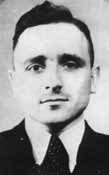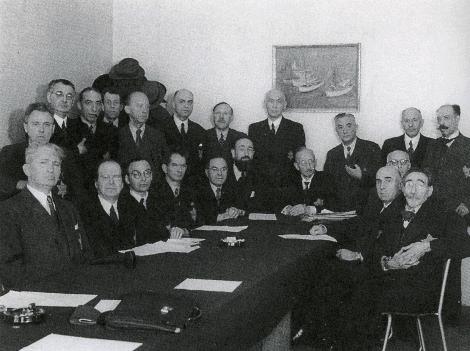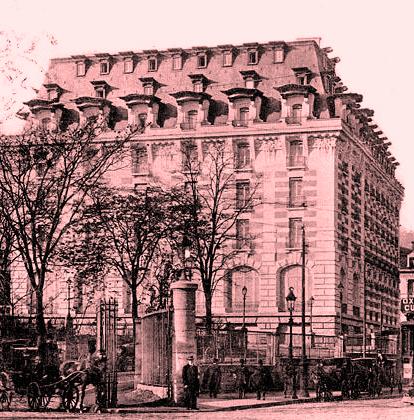In 1944 the Nazis decided to exterminate the children of the orphanage La Maison d'Izieu. 44 little children were deported to Auschwitz and murdered immediately upon arrival.
Eleven-year-old Liliane Gerenstein was sent to her death a few days after she wrote this letter to God:
"God? How good You are, how kind and if one had to count the number of goodnesses and kindnesses You have done, one would never finish.
God? It is You who command. It is You who are justice, it is You who reward the good and punish the evil.
God? It is thanks to You that I had a beautiful life before, that I was spoiled, that I had lovely things that others do not have.
God? After that, I ask You one thing only: Make my parents come back, my poor parents protect them (even more than You protect me) so that I can see them again as soon as possible.
Make them come back again. Ah! I had such a good mother and such a good father! I have such faith in You and I thank You in advance."
God? It is You who command. It is You who are justice, it is You who reward the good and punish the evil.
God? It is thanks to You that I had a beautiful life before, that I was spoiled, that I had lovely things that others do not have.
God? After that, I ask You one thing only: Make my parents come back, my poor parents protect them (even more than You protect me) so that I can see them again as soon as possible.
Make them come back again. Ah! I had such a good mother and such a good father! I have such faith in You and I thank You in advance."
The letter was found in April 1944 in the abandoned home in Izieu. Liliane's mother had been deported and was already murdered. Her father, Chapse, miraculously survived the horrors of the Holocaust and emigrated to the United States after the war. He died in 1979, never knowing the fate of his children.
The sleepy village of Izieu lay overlooking the Rhone River between Lyon and Chambery in central France. The children, aged between 3 and 18, felt safe and secure, supervised by seven adults. The Children's Home was a perfect idyll and the Jewish children led a happy life with plenty of time for playing, drawing and painting.
However, on the morning of April 6, 1944 - a warm day, no clouds, bright sun - as they all settled down in the refectory to drink hot chocolate, three vehicles, two of which were lorries, pulled up in front of the home. The Gestapo, led by the Butcher of Lyon Klaus Barbie, entered the home and forcibly removed the children and their supervisors, throwing the crying and terrified children on to the trucks like sacks of potatoes.
Then the SS men ransacked the house and several more children were discovered hiding under a table in the attic classroom. In the confusion one small boy began racing across the courtyard, but the SS men grabbed him and beat him with rifle butts. Blood streamed from his nose as he was thrown into the truck. The last child, a blond boy of 3, too terrified to walk, was carried into the truck.
Following the raid on their home in Izieu, the children were taken directly to the cellar of the Fort Montluc Prison in Lyons. The very next morning Klaus Barbie arranged for the cattle cars that would take the children to the 'collection center' in Drancy. Then they were put on the first available train towards the death camps in the East.
Forty-two children and five adults were gassed in the extermination camp of Auschwitz. Two of the oldest children and Miron Zlatin, the superintendent, ended up in Tallin in Estonia and were put to death by a firing squad.
Of the forty-four children kidnapped by the Nazis in Izieu, not a single one survived. Of the supervisors there was one sole survivor, twenty-seven year old Lea Feldblum. When the children from Izieu arrived in Auschwitz on April 15, 1944, Léa led the column of children to the selection point. When she informed the SS that these children were from a home, she was ruthlessly separated from them and sent to the prisoners' camp.
At the later trial of Klaus Barbie a witness, Edith Klebinder, testified that the children were put to death immediately upon arrival at Auschwitz. She was an Austrian-born Jew and was deported from France to Auschwitz April, 1944, and arrived at the death camp on April 15 aboard the same train as the Izieu children. The Nazi guards ordered Klebinder, who was fluent in French and German, to translate as they ordered children and pregnant women onto trucks and told the other arrivals to walk to the camp.
Edith Klebinder - in a voice choked with emotion - told she at first thought the children and pregnant women were given rides to the camp out of compassion. Later, she said, she asked what had become of the children:
The sleepy village of Izieu lay overlooking the Rhone River between Lyon and Chambery in central France. The children, aged between 3 and 18, felt safe and secure, supervised by seven adults. The Children's Home was a perfect idyll and the Jewish children led a happy life with plenty of time for playing, drawing and painting.
However, on the morning of April 6, 1944 - a warm day, no clouds, bright sun - as they all settled down in the refectory to drink hot chocolate, three vehicles, two of which were lorries, pulled up in front of the home. The Gestapo, led by the Butcher of Lyon Klaus Barbie, entered the home and forcibly removed the children and their supervisors, throwing the crying and terrified children on to the trucks like sacks of potatoes.
Then the SS men ransacked the house and several more children were discovered hiding under a table in the attic classroom. In the confusion one small boy began racing across the courtyard, but the SS men grabbed him and beat him with rifle butts. Blood streamed from his nose as he was thrown into the truck. The last child, a blond boy of 3, too terrified to walk, was carried into the truck.
Following the raid on their home in Izieu, the children were taken directly to the cellar of the Fort Montluc Prison in Lyons. The very next morning Klaus Barbie arranged for the cattle cars that would take the children to the 'collection center' in Drancy. Then they were put on the first available train towards the death camps in the East.
Forty-two children and five adults were gassed in the extermination camp of Auschwitz. Two of the oldest children and Miron Zlatin, the superintendent, ended up in Tallin in Estonia and were put to death by a firing squad.
Of the forty-four children kidnapped by the Nazis in Izieu, not a single one survived. Of the supervisors there was one sole survivor, twenty-seven year old Lea Feldblum. When the children from Izieu arrived in Auschwitz on April 15, 1944, Léa led the column of children to the selection point. When she informed the SS that these children were from a home, she was ruthlessly separated from them and sent to the prisoners' camp.
At the later trial of Klaus Barbie a witness, Edith Klebinder, testified that the children were put to death immediately upon arrival at Auschwitz. She was an Austrian-born Jew and was deported from France to Auschwitz April, 1944, and arrived at the death camp on April 15 aboard the same train as the Izieu children. The Nazi guards ordered Klebinder, who was fluent in French and German, to translate as they ordered children and pregnant women onto trucks and told the other arrivals to walk to the camp.
Edith Klebinder - in a voice choked with emotion - told she at first thought the children and pregnant women were given rides to the camp out of compassion. Later, she said, she asked what had become of the children:
"I asked myself where were the children who arrived with us? In the camp there wasn't a single child to be seen. Then those who had been there for a while informed us of the reality. "You see that chimney, the one smoke never stops coming out of .. you smell that odor of burned flesh ..."
- Louis Bülow
Bibliography/Sources:
Beate and Serge KlarsfeldMusee Memorial des Enfants d’Izieu (Memorial Museum of the Children of Izieu) www.izieu.alma.fr/
French Children of the Holocaust A Memorialby Serge Klarsfeld
Children of Izieu: A Human Tragedy, by Serge Klarsfeld. New York, Abrams 1984
Bolivia Web "The Outsiders"
Philippe Brunet-Lecomte, "Les trois traîtres français d'Izieu," Lyon Figaro 2 June, 1987
Pierre Bois, "D'Izieu à Auschwitz, le martyre de 44 enfants," Le Figaro 28 May, 1987
Letter from Izieu By Raphael Rothstein
The Consortium by Martin A. Lee
The History of Espionage www.theoffice.net/1spy
The Macedonian News Service
The Philadelphia Inquirer
The Simon Wiesenthal Center www.wiesenthal.com/







